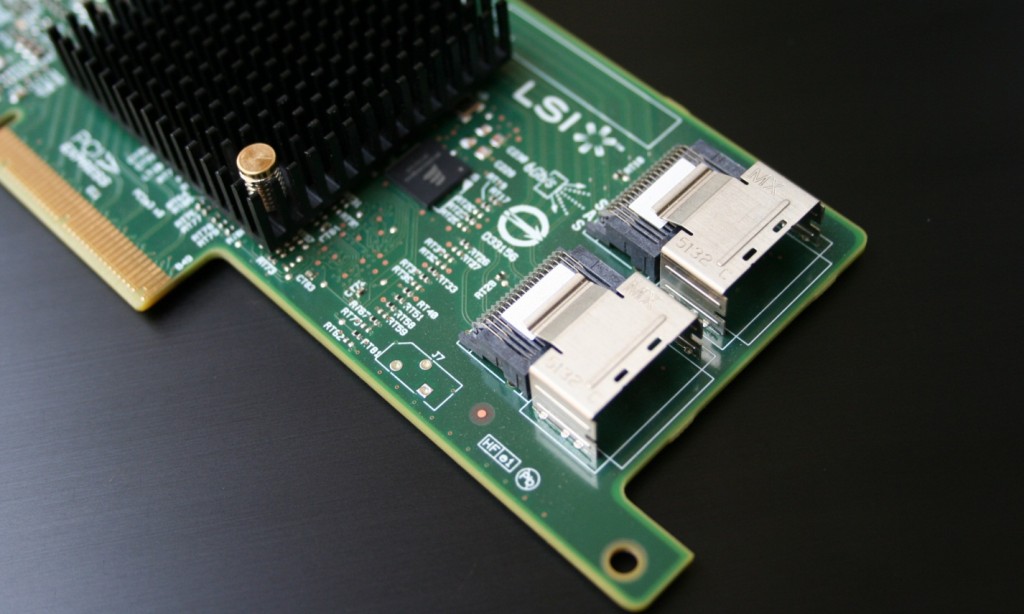New standards take time to design, ratify, and implement. As one standard proliferates, the next version is already in the works. Just as SATA II gave way to SATA III, PCIe Gen 2 devices are being replaced by PCIe Gen 3.
LSI has finally lifted the veil on it’s new PCIe 3.0 family of MegaRAID and HBA controllers. PCIe 3.0 increases theoretical per-lane bandwidth by 100% over PCIe Gen 2, resulting in massive bandwidth increases.
In the case of LSI’s storage products, this means more throughput and IOPS are on offer, especially when joined with solid state storage. To that end, LSI announced ten new products today, comprised of seven new RAID cards and three new HBA products.
The LSI2208/2308 RoCs (RAID-on-Chip) are the foundation for LSI’s PCI Express 3.0 MegaRAID offerings. The 2208/2308 “Thunderbolt” is powered by two IBM Power PC cores running at 800MHz and paired with 1GB of cache. The Gen 3s support CacheCade Pro 2.0 and Fast Path, with two of the newly announced SKUs include CacheCade Pro.
When combined with Fast Path, the MegaRAIDs can exceed 460,000 IOPS if used with solid state storage. LSI is also touting improvements in write performance for arrays when using RAID levels 5 or 6 (up to 2.5GB/s writes) thanks to new refinements, more RoC horsepower, and PCIe 3.
The three HBAs include a LSI 9207-8i (2x SFF8087 mini SAS ports), a 9207-8e (2x SFF8088 external ports), and a combination 9207-4i4e (internal and external) offering. The 8i supports up to 256 drives, while the 8e supports up to 1024. Currently shipping Gen 3 HBAs are flashed with IT firmware by default, though IR firmware should be available shortly.
LSI claims their Fusion-MPT 2 architecture is good for around 700,000 IOPS. 6Gbps controllers on PCIe 2.0 slots could easily saturate available bandwidth with 6Gbps capable SSDs. With PCIe 3 controllers, it’s a different story. Until 12Gbps devices and controllers become mainstream, tapping out a PCIe 3 controller could be easier said than done.
Stay tuned in the next day or so as we already have the new LSI PCIe Gen 3 HBA in our hot little hands and have already reached performance of 4.1GB/s and 370,000 IOPS with just a quick feel!
 The SSD Review The Worlds Dedicated SSD Education and Review Resource |
The SSD Review The Worlds Dedicated SSD Education and Review Resource | 

> PCIe Gen 2 devices are being replaced by PCIe Gen 3
We need to reiterate 2 key features of PCIe Gen 3:
8 GHz clock rate AND 130b/128b “jumbo frames”.
By design, these 2 features result in 8G / 8b = ~1.0 GB/second throughput
at the chipset level, for a single x1 PCIe “lane”.
However, current 6G SSDs remain limited by
6 GHz clock rates AND 10b/8b “legacy frames”,
and the best are now bumping against this
“glass ceiling” e.g. 550 MB/second READS.
So, we can raise the ceiling by increasing the
clock rate to 8G (at least) or 12G and
keeping legacy frames, like this:
8G / 10b = 800 MB/second
12G / 10b = 1,200 MB/second
But, the PCIe Gen3 spec offers a wonderful opportunity
to “sync” it with all future SATA standards, i.e. by also adding
the 130b/128b “jumbo frame” to the SATA standard e.g.:
8G / 8b = ~1.0 GB/second per channel
12G / 8b = ~1.5 GB/second per channel
16G / 8b = ~2.0 GB/second per channel
… and so on.
Dropping 2 extra bits from every byte transmitted
should also eliminate a lot of overhead in
controllers at both ends of the data cables!
FYI: More details are at the Forums here:
“SATA-IV” Proposal: A Flexible Topology for PCIe 3.0
MRFS
I haven’t found any decent information anywhere between the 2308 and the 2208 chips; this article is similarly vague. Any ideas where to find the differences?